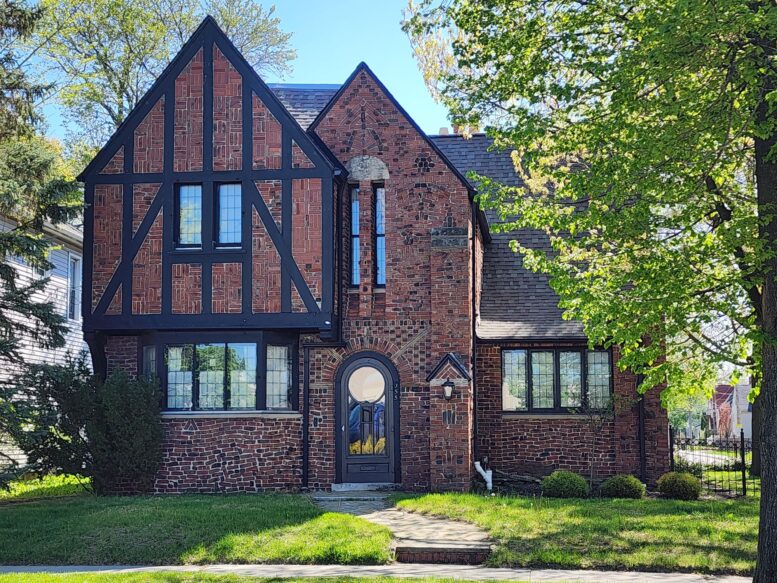(Written by Eric Buetikofer and Jessica Turos, owners)
The history of 155 South Prospect Street can be traced back to the Andrew Jackson land grant era, when in 1833 Alfred Thurstin bought 109 acres east of Main Street in Bowling Green, including the plot of land now at the northeast corner of South Prospect and Clough Streets.
The property was sold multiple times from 1866 through 1925 when Leo Herman, a prominent Bowling Green contractor, bought it to build a home for his family. Herman built the house in 1926. The current residents, Eric Buetikofer and Jessica Turos, are the seventh owners.
Herman’s family sold the home in 1940 to Helen D. Bowen, who lived there until 1948, when Gus Keller & Margurerite Keller bought the house. Then the property was sold two years later, in 1950, to John Belvin Price Jr. and Mary Fitzgerald, who sold the home two years after purchasing it in 1952, to Jerry O. Crist.
Ivan and Myrl DenBesten purchased the home in 1963 and lived there for nearly 50 years. Dr. Ivan DenBesten was a chemistry professor at Bowling Green State University (BGSU) for nearly 40 years, and Myrl was an early childhood educator in the BG city schools. They raised their children, Bill and Karen, and spent much time with their grandchildren there. The DenBestens had three dogs, Peppie, Ginger, and Mollie, who was known as the neighborhood “fence monitor.”
The DenBestens rented the house in the spring of 1966 to Dr. Oster, a fruit fly researcher in the BGSU Biology Department, while they were at Argon National Lab in Illinois, where Ivan was doing research. From 1973-1975, they also rented the house to Drs. Mel and Joy Hyman, director of the Speech and Hearing Clinic at BGSU, when Ivan was a visiting professor of chemistry and Myrl was the director of the pre-school for faculty children at the University of Petroleum and Minerals in Dhahran, Saudi Arabia.
In 2010, the DenBestens sold the house to Eric Buetikofer and Jessica Turos who have lived there ever since. Jessica and Eric have had four dogs live with them; Dakota and Cali have since passed and Indi and Penny are continuing “fence monitor” duties.
The house at 155 South Prospect Street has some interesting connections to the Bowling Green area. It was designed by the same architect of St. Aloysius and Nazareth Hall, John T. Comes of Pittsburgh, Pennsylvania. The house was built by Leo Herman as a home for his family. He was a successful contractor, and came to Bowling Green from Edgerton, Ohio, in 1924 when he received the contract for St. Aloysius Church.
In addition to St. Aloysius Church, Herman built numerous historic Bowling Green buildings, such as the Commercial Bank building, still at 130 South Main Street and the Men’s Gymnasium (new Eppler South) at the State Normal College (now BGSU). Herman also built the original Bowling Green City Pool in 1930. Leo lived in the home until he passed away from a stroke in 1931.
The Tudor Revival brick house has some unique design and historical elements. The entryway tile of the house is the same tile used in St. Aloysius Church. This was a signature common to all the buildings built by the construction firm that built the house. The home has a unique brick design, called skittle brick, that originated in England. Brick layers would take bits of brick that broke during the firing process and use them to create mosaics and patterns in the exterior walls. There is also a knight emblem in cement near the peak of the house that we believe was part of a family coat of arms, but we cannot verify this.
The bricks used for the flowerbeds are reclaimed pavers from Court Street from 1988. The flagstone was reclaimed from old flagstone sidewalks around town in 1988. The patio was inspired by the courtyards the DenBestens visited in New Orleans. The last time the fireplace was used was during the blizzard of 1978. The property has unique foliage. In the side yard, the lace leaf Japanese maple tree is almost 60 years old and was planted in 1968. There is a second lace leaf Japanese maple tree by the driveway that was planted in 2001. The large oak trees were planted in 1985, and the side yard has one of the only green ash trees in the area.
The house was involved in an infamous moment in history. In 1931, a shootout happened right in front of the property on Clough and Prospect. William Miller (aka “Billy the Killer”) and Charles Arthur Floyd (aka “Pretty Boy Floyd”) exchanged fire with Chief Galliher and Officer Castner. Miller started his short life of crime when he killed his brother, Joseph Miller, in Beaver County, Pennsylvania, in 1925 during a fight over a woman. Miller was part of “Pretty Boy Floyd’s” gang and committed numerous bank heists. “Pretty Boy Floyd” was a well-known bank robber and outlaw who burned mortgage documents during his robberies, freeing many people from their debts. Beulah Baird and Ava Baird were with Miller and Floyd when the shooting started. The quartet drew suspicion from Bowling Green shopkeepers because of Beulah and Ava’s frequent purchases of expensive clothing paid for with large denominations.
Shopkeepers notified the police, and when they confronted Floyd and Miller the shooting began. Miller was shot and killed, Behlah was shot as well in the crossfire. Unfortunately, Floyd shot and killed BG Patrolman Ralph Castner, a BGSU alumnus, in the altercation.
The property has had some exciting history and the homeowners look forward to more adventures.
Would you like to nominate a historic building or site for recognition? You can do this through the city website at – https://www.bgohio.org/FormCenter/Planning-13/Historic-BuildingSite-Nomination-Form-83
You can learn more about the Historic Preservation Commission by attending their meetings (the fourth Tuesday of each month at 4 p.m.) or by visiting their webpage at – https://www.bgohio.org/436/Historic-Preservation-Commission.

